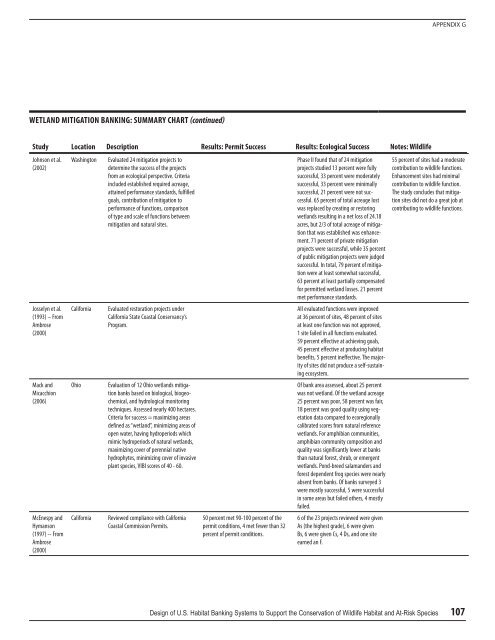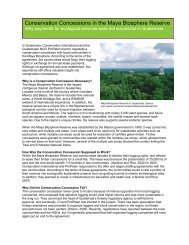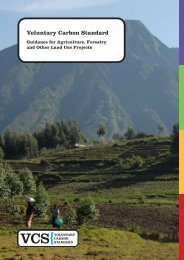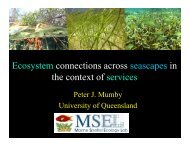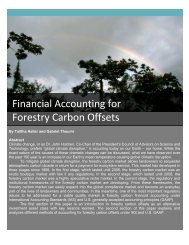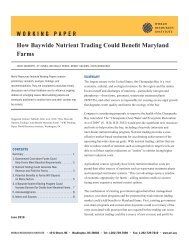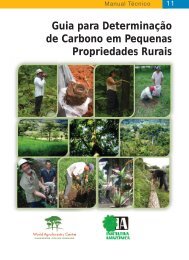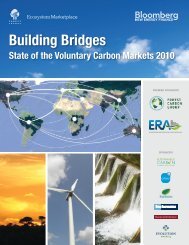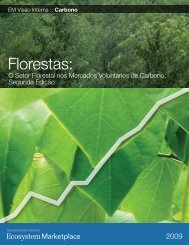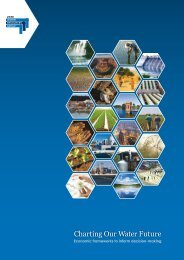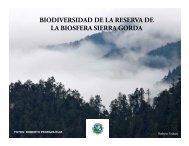Design of US Habitat Banking Systems to Support the Conservation ...
Design of US Habitat Banking Systems to Support the Conservation ...
Design of US Habitat Banking Systems to Support the Conservation ...
You also want an ePaper? Increase the reach of your titles
YUMPU automatically turns print PDFs into web optimized ePapers that Google loves.
APPENDIX GWETLAND MITIGATION BANKING: SUMMARY CHART (continued)Study Location Description Results: Permit Success Results: Ecological Success Notes: WildlifeJohnson et al.(2002)Josselyn et al.(1993) – FromAmbrose(2000)Mack andMicacchion(2006)McEnespy andHymanson(1997) -- FromAmbrose(2000)Washing<strong>to</strong>nCaliforniaOhioCaliforniaEvaluated 24 mitigation projects <strong>to</strong>determine <strong>the</strong> success <strong>of</strong> <strong>the</strong> projectsfrom an ecological perspective. Criteriaincluded established required acreage,attained performance standards, fulfilledgoals, contribution <strong>of</strong> mitigation <strong>to</strong>performance <strong>of</strong> functions, comparison<strong>of</strong> type and scale <strong>of</strong> functions betweenmitigation and natural sites.Evaluated res<strong>to</strong>ration projects underCalifornia State Coastal Conservancy’sProgram.Evaluation <strong>of</strong> 12 Ohio wetlands mitigationbanks based on biological, biogeochemical,and hydrological moni<strong>to</strong>ringtechniques. Assessed nearly 400 hectares.Criteria for success = maximizing areasdefined as “wetland”, minimizing areas <strong>of</strong>open water, having hydroperiods whichmimic hydroperiods <strong>of</strong> natural wetlands,maximizing cover <strong>of</strong> perennial nativehydrophytes, minimizing cover <strong>of</strong> invasiveplant species, VIBI scores <strong>of</strong> 40 - 60.Reviewed compliance with CaliforniaCoastal Commission Permits.50 percent met 90-100 percent <strong>of</strong> <strong>the</strong>permit conditions, 4 met fewer than 32percent <strong>of</strong> permit conditions.Phase II found that <strong>of</strong> 24 mitigationprojects studied 13 percent were fullysuccessful, 33 percent were moderatelysuccessful, 33 percent were minimallysuccessful, 21 percent were not successful.65 percent <strong>of</strong> <strong>to</strong>tal acreage lostwas replaced by creating or res<strong>to</strong>ringwetlands resulting in a net loss <strong>of</strong> 24.18acres, but 2/3 <strong>of</strong> <strong>to</strong>tal acreage <strong>of</strong> mitigationthat was established was enhancement.71 percent <strong>of</strong> private mitigationprojects were successful, while 35 percent<strong>of</strong> public mitigation projects were judgedsuccessful. In <strong>to</strong>tal, 79 percent <strong>of</strong> mitigationwere at least somewhat successful,63 percent at least partially compensatedfor permitted wetland losses. 21 percentmet performance standards.All evaluated functions were improvedat 36 percent <strong>of</strong> sites, 48 percent <strong>of</strong> sitesat least one function was not approved,1 site failed in all functions evaluated.59 percent effective at achieving goals,45 percent effective at producing habitatbenefits, 5 percent ineffective. The majority<strong>of</strong> sites did not produce a self-sustainingecosystem.Of bank area assessed, about 25 percentwas not wetland. Of <strong>the</strong> wetland acreage25 percent was poor, 58 percent was fair,18 percent was good quality using vegetationdata compared <strong>to</strong> ecoregionallycalibrated scores from natural referencewetlands. For amphibian communities,amphibian community composition andquality was significantly lower at banksthan natural forest, shrub, or emergentwetlands. Pond-breed salamanders andforest dependent frog species were nearlyabsent from banks. Of banks surveyed 3were mostly successful, 5 were successfulin some areas but failed o<strong>the</strong>rs, 4 mostlyfailed.6 <strong>of</strong> <strong>the</strong> 23 projects reviewed were givenAs (<strong>the</strong> highest grade), 6 were givenBs, 6 were given Cs, 4 Ds, and one siteearned an F.55 percent <strong>of</strong> sites had a moderatecontribution <strong>to</strong> wildlife functions.Enhancement sites had minimalcontribution <strong>to</strong> wildlife function.The study concludes that mitigationsites did not do a great job atcontributing <strong>to</strong> wildlife functions.<strong>Design</strong> <strong>of</strong> U.S. <strong>Habitat</strong> <strong>Banking</strong> <strong>Systems</strong> <strong>to</strong> <strong>Support</strong> <strong>the</strong> <strong>Conservation</strong> <strong>of</strong> Wildlife <strong>Habitat</strong> and At-Risk Species 107


